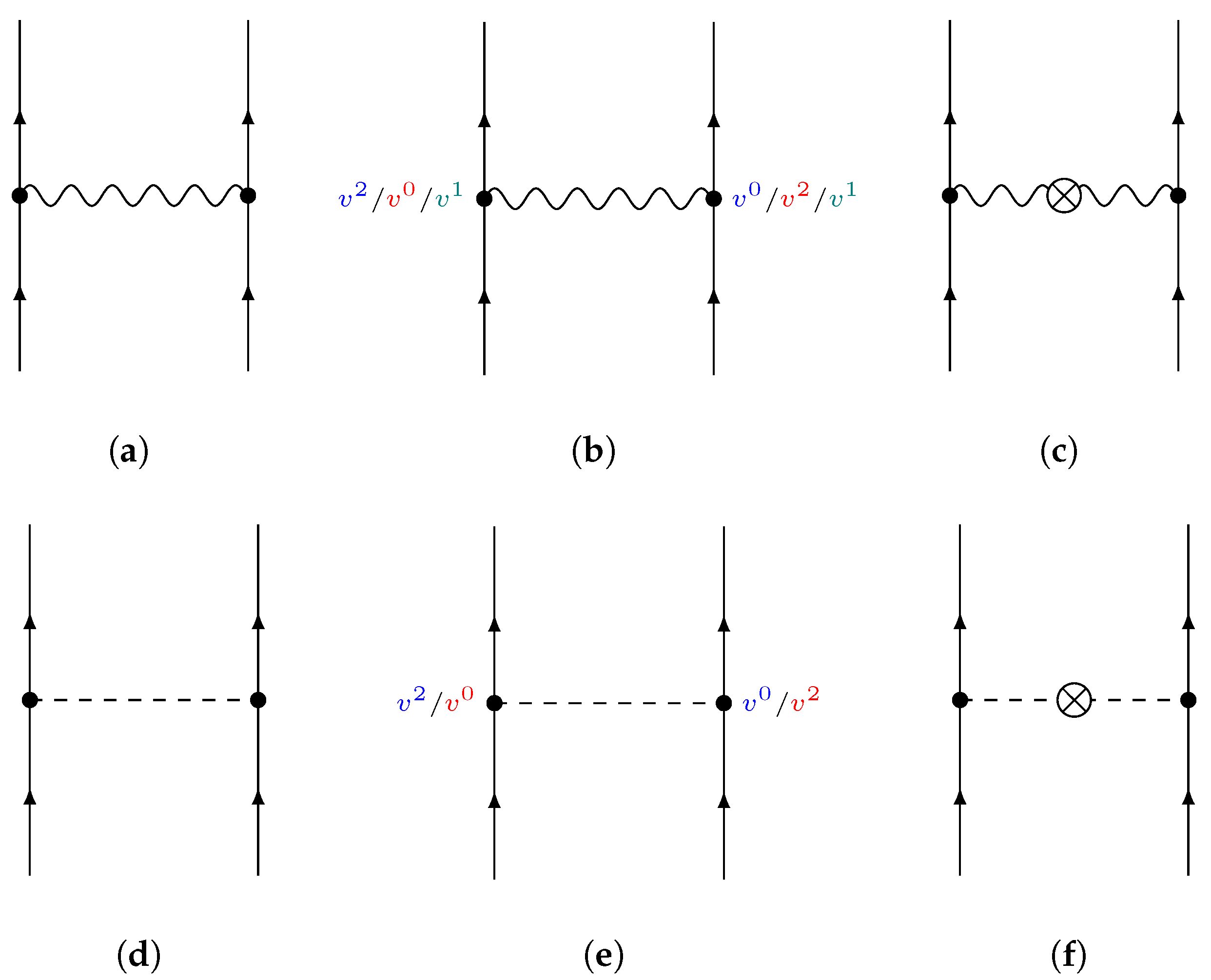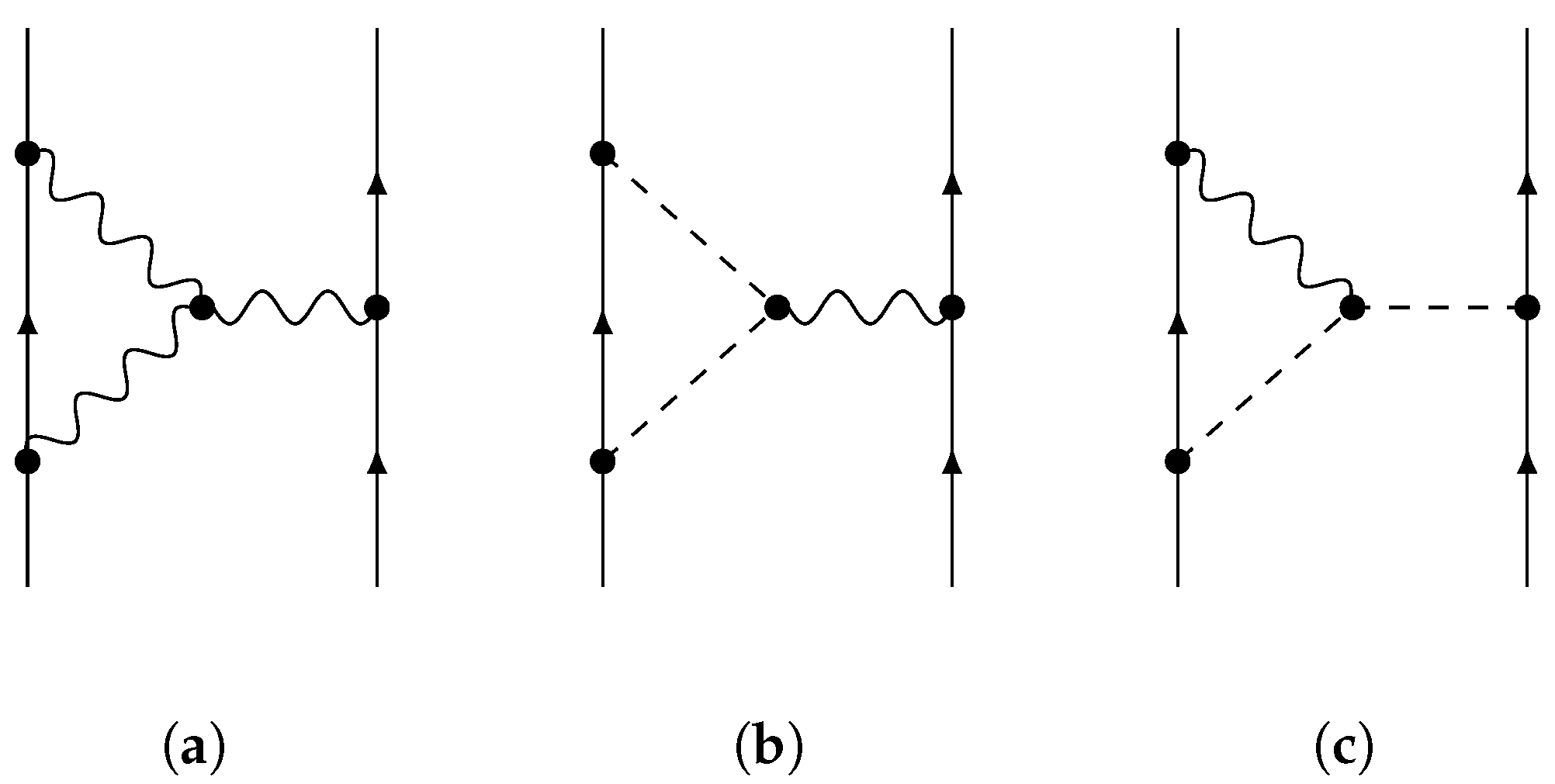1PN Effective Binary Lagrangian for the Gravity–Kalb–Ramond Sector in the Conservative Regime
Abstract
1. Introduction
2. Effective Action for the Kalb–Ramond Field
2.1. A Solution for the Kalb–Ramond Field
2.2. Relativistic Expansion of the Action
2.3. The Graviton and Point-Particle Action
2.4. Equations of Motion for the Gravity–Kalb–Ramond Sector
3. Expanding the Action into the 1PN Order
3.1. Velocity Corrections to the 0PN Diagrams
3.2. Higher-Order Diagrams: Seagull
3.3. Higher-Order Diagrams: Field Interactions
3.3.1. The Corresponding Potential of Figure 4a
3.3.2. The Corresponding Potential of Figure 4b
3.3.3. The Corresponding Potential of Figure 4c
4. The Resulting Binary Lagrangian
Some Observable Consequences
5. Conclusions and Outlook
Author Contributions
Funding
Data Availability Statement
Acknowledgments
Conflicts of Interest
| 1 | |
| 2 | |
| 3 | We here define the action as ; thus, we may write for notational convenience. |
| 4 | This factor is not summed over . |
| 5 | To obtain this result one needs the relation . This relation can be argued for from in four space-time dimensions. Then, it follows straightforwardly that . |
| 6 | This is required by relativity because there are no privileged time coordinates, and ensuring reparametrization invariance allows classical particles to have the correct number of degrees of freedom. This requirement is also equivalent to the condition [30], pp. 350–352. |
| 7 | For those familiar with the bar operator introduced in [31], is the bar operator, which is also its own inverse. |
| 8 | For more rigour, impose particle coordinates before performing the momentum integrals. Then, one obtains terms like , which also diverge to infinity. |
| 9 | This should produce gravitational waves with frequencies around , putting the system in the sensitive-frequency band of ground-based detectors. |
References
- Peccei, R.D.; Quinn, H.R. CP Conservation in the Presence of Instantons. Phys. Rev. Lett. 1977, 38, 1440–1443. [Google Scholar] [CrossRef]
- Wilczek, F. Problem of Strong P and T Invariance in the Presence of Instantons. Phys. Rev. Lett. 1978, 40, 279–282. [Google Scholar] [CrossRef]
- Weinberg, S. A New Light Boson? Phys. Rev. Lett. 1978, 40, 223–226. [Google Scholar] [CrossRef]
- Kim, J.E. Weak Interaction Singlet and Strong CP Invariance. Phys. Rev. Lett. 1979, 43, 103. [Google Scholar] [CrossRef]
- Vafa, C.; Witten, E. Parity Conservation in QCD. Phys. Rev. Lett. 1984, 53, 535. [Google Scholar] [CrossRef]
- Grilli di Cortona, G.; Hardy, E.; Pardo Vega, J.; Villadoro, G. The QCD axion, precisely. J. High Energy Phys. 2016, 1, 034. [Google Scholar] [CrossRef]
- Svrcek, P.; Witten, E. Axions in String Theory. J. High Energy Phys. 2006, 6, 051. [Google Scholar] [CrossRef]
- Arvanitaki, A.; Dimopoulos, S.; Dubovsky, S.; Kaloper, N.; March-Russell, J. String Axiverse. Phys. Rev. D 2010, 81, 123530. [Google Scholar] [CrossRef]
- Marsh, D.J.E. Axion Cosmology. Phys. Rept. 2016, 643, 1–79. [Google Scholar] [CrossRef]
- Huang, J.; Johnson, M.C.; Sagunski, L.; Sakellariadou, M.; Zhang, J. Prospects for axion searches with Advanced LIGO through binary mergers. Phys. Rev. D 2019, 99, 063013. [Google Scholar] [CrossRef]
- Kalb, M.; Ramond, P. Classical direct interstring action. Phys. Rev. D 1974, 9, 2273–2284. [Google Scholar] [CrossRef]
- Burgess, C.P.; Myers, R.C.; Quevedo, F. On spherically symmetric string solutions in four-dimensions. Nucl. Phys. B 1995, 442, 75–96. [Google Scholar] [CrossRef]
- Kang, S.; Yeom, D.H. Causal structures and dynamics of black-hole-like solutions in string theory. Eur. Phys. J. C 2019, 79, 927. [Google Scholar] [CrossRef]
- Afzal, A.; Agazie, G.; Anumarlapudi, A.; Archibald, A.M.; Arzoumanian, Z.; Baker, P.T.; Bécsy, B.; Blanco-Pillado, J.J.; Blecha, L.; Boddy, K.K.; et al. The NANOGrav 15 yr Data Set: Search for Signals from New Physics. Astrophys. J. Lett. 2023, 951, L11. [Google Scholar] [CrossRef]
- Copeland, E.J.; Myers, R.C.; Polchinski, J. Cosmic F and D strings. J. High Energy Phys. 2004, 6, 013. [Google Scholar] [CrossRef]
- Mathur, S.D. The Fuzzball proposal for black holes: An Elementary review. Fortsch. Phys. 2005, 53, 793–827. [Google Scholar] [CrossRef]
- Kramer, M.; Stairs, I.H.; Manchester, R.N.; Wex, N.; Deller, A.T.; Coles, W.A.; Ali, M.; Burgay, M.; Camilo, F.; Cognard, I.; et al. Strong-Field Gravity Tests with the Double Pulsar. Phys. Rev. X 2021, 11, 041050. [Google Scholar] [CrossRef]
- Abbott, B.P.; Abbott, R.; Abbott, T.D.; Abraham, S.; Acernese, F.; Ackley, K.; Adams, C.; Adhikari, R.X.; Adya, V.B.; Affeldt, C.; et al. Tests of General Relativity with the Binary Black Hole Signals from the LIGO-Virgo Catalog GWTC-1. Phys. Rev. D 2019, 100, 104036. [Google Scholar] [CrossRef]
- Abbott, B.P.; Abbott, R.; Abbott, T.D.; Abraham, S.; Acernese, F.; Ackley, K.; Adams, C.; Adya, V.B.; Affeldt, C.; Agathos, M.; et al. Prospects for observing and localizing gravitational-wave transients with Advanced LIGO, Advanced Virgo and KAGRA. Living Rev. Rel. 2018, 21, 3. [Google Scholar] [CrossRef]
- Maggiore, M.; Van Den Broeck, C.; Bartolo, N.; Belgacem, E.; Bertacca, D.; Bizouard, M.A.; Branchesi, M.; Clesse, S.; Foffa, S.; García-Bellido, J.; et al. Science Case for the Einstein Telescope. J. Cosmol. Astropart. Phys. 2020, 3, 050. [Google Scholar] [CrossRef]
- Barausse, E.; Berti, E.; Hertog, T.; Hughes, S.A.; Jetzer, P.; Pani, P.; Sotiriou, T.P.; Tamanini, N.; Witek, H.; Yagi, K.; et al. Prospects for Fundamental Physics with LISA. Gen. Rel. Grav. 2020, 52, 81. [Google Scholar] [CrossRef]
- Goldberger, W.D.; Rothstein, I.Z. Effective field theory of gravity for extended objects. Phys. Rev. D 2006, 73, 104029. [Google Scholar] [CrossRef]
- Goldberger, W.D. Les Houches Lectures on Effective Field Theories and Gravitational Radiation. arXiv 2007, arXiv:hep-ph/0701129. [Google Scholar] [CrossRef]
- Bhattacharyya, A.; Ghosh, S.; Pal, S. Worldline effective field theory of inspiralling black hole binaries in presence of dark photon and axionic dark matter. J. High Energy Phys. 2023, 2023, 207. [Google Scholar] [CrossRef]
- Garnier, C.J. Modeling Axion-Graviton Interactions from an Effective Action Approach. Master’s Thesis, California State University Sacramento, Sacramento, CA, USA, 2021. [Google Scholar]
- Undheim, V. First Post-Newtonian Correction to Gravitational Waves Produced by Compact Binaries: How to Compute Relativistic Corrections to Gravitational Waves Using Feynman Diagrams. Master’s Thesis, NTNU, Trondheim, Norway, 2021. [Google Scholar] [CrossRef]
- Hitchin, N. Lectures on generalized geometry. arXiv 2010, arXiv:1008.0973. [Google Scholar] [CrossRef]
- Coimbra, A.; Strickland-Constable, C.; Waldram, D. Supergravity as Generalised Geometry I: Type II Theories. J. High Energy Phys. 2011, 11, 091. [Google Scholar] [CrossRef]
- Coimbra, A.; Strickland-Constable, C.; Waldram, D. Supergravity as Generalised Geometry II: Ed(d) × ℝ+ and M theory. J. High Energy Phys. 2014, 3, 19. [Google Scholar] [CrossRef]
- Gourgoulhon, E. Special Relativity in General Frames; Graduate Texts in Physics; Springer: Berlin/Heidelberg, Germany, 2013. [Google Scholar] [CrossRef]
- Feynman, R. Feynman Lectures on Gravitation; CRC Press: Boca Raton, FL, USA, 1996. [Google Scholar] [CrossRef]
- Choi, S.Y.; Shim, J.S.; Song, H.S. Factorization and polarization in linearized gravity. Phys. Rev. D 1995, 51, 2751–2769. [Google Scholar] [CrossRef]
- Porto, R.A. The effective field theorist’s approach to gravitational dynamics. Phys. Rep. 2016, 633, 1–104. [Google Scholar] [CrossRef]
- Iorio, L. General Post-Newtonian Orbital Effects: From Earth’s Satellites to the Galactic Centre; Cambridge University Press: Cambridge, UK, 2024. [Google Scholar] [CrossRef]
- Abedi, J. Firewall black holes and echoes from an action principle. Phys. Rev. D 2023, 107, 064004. [Google Scholar] [CrossRef]




Disclaimer/Publisher’s Note: The statements, opinions and data contained in all publications are solely those of the individual author(s) and contributor(s) and not of MDPI and/or the editor(s). MDPI and/or the editor(s) disclaim responsibility for any injury to people or property resulting from any ideas, methods, instructions or products referred to in the content. |
© 2025 by the authors. Licensee MDPI, Basel, Switzerland. This article is an open access article distributed under the terms and conditions of the Creative Commons Attribution (CC BY) license (https://creativecommons.org/licenses/by/4.0/).
Share and Cite
Undheim, V.; Svanes, E.E.; Nielsen, A.B. 1PN Effective Binary Lagrangian for the Gravity–Kalb–Ramond Sector in the Conservative Regime. Galaxies 2025, 13, 79. https://doi.org/10.3390/galaxies13040079
Undheim V, Svanes EE, Nielsen AB. 1PN Effective Binary Lagrangian for the Gravity–Kalb–Ramond Sector in the Conservative Regime. Galaxies. 2025; 13(4):79. https://doi.org/10.3390/galaxies13040079
Chicago/Turabian StyleUndheim, Vegard, Eirik Eik Svanes, and Alex B. Nielsen. 2025. "1PN Effective Binary Lagrangian for the Gravity–Kalb–Ramond Sector in the Conservative Regime" Galaxies 13, no. 4: 79. https://doi.org/10.3390/galaxies13040079
APA StyleUndheim, V., Svanes, E. E., & Nielsen, A. B. (2025). 1PN Effective Binary Lagrangian for the Gravity–Kalb–Ramond Sector in the Conservative Regime. Galaxies, 13(4), 79. https://doi.org/10.3390/galaxies13040079








